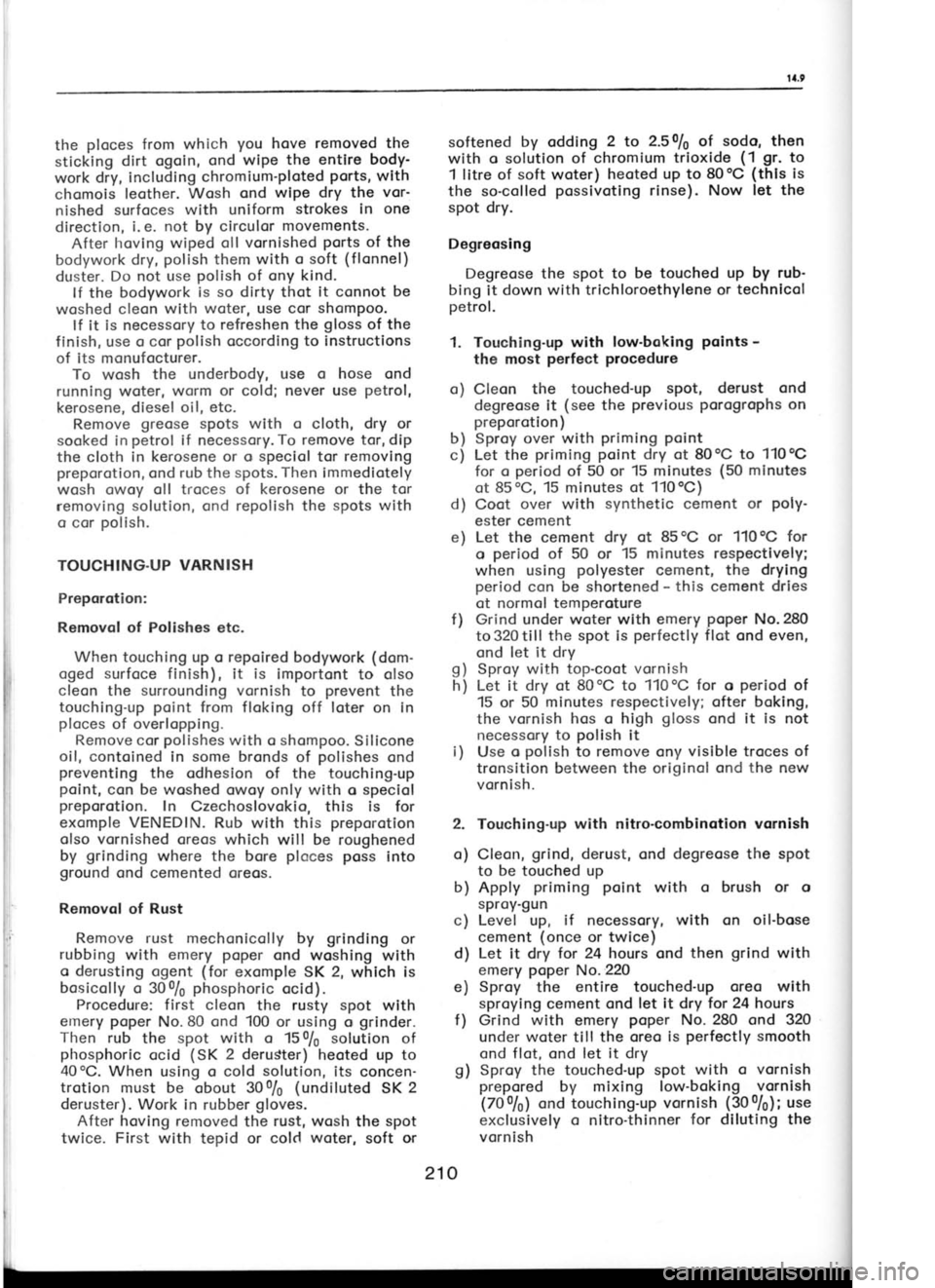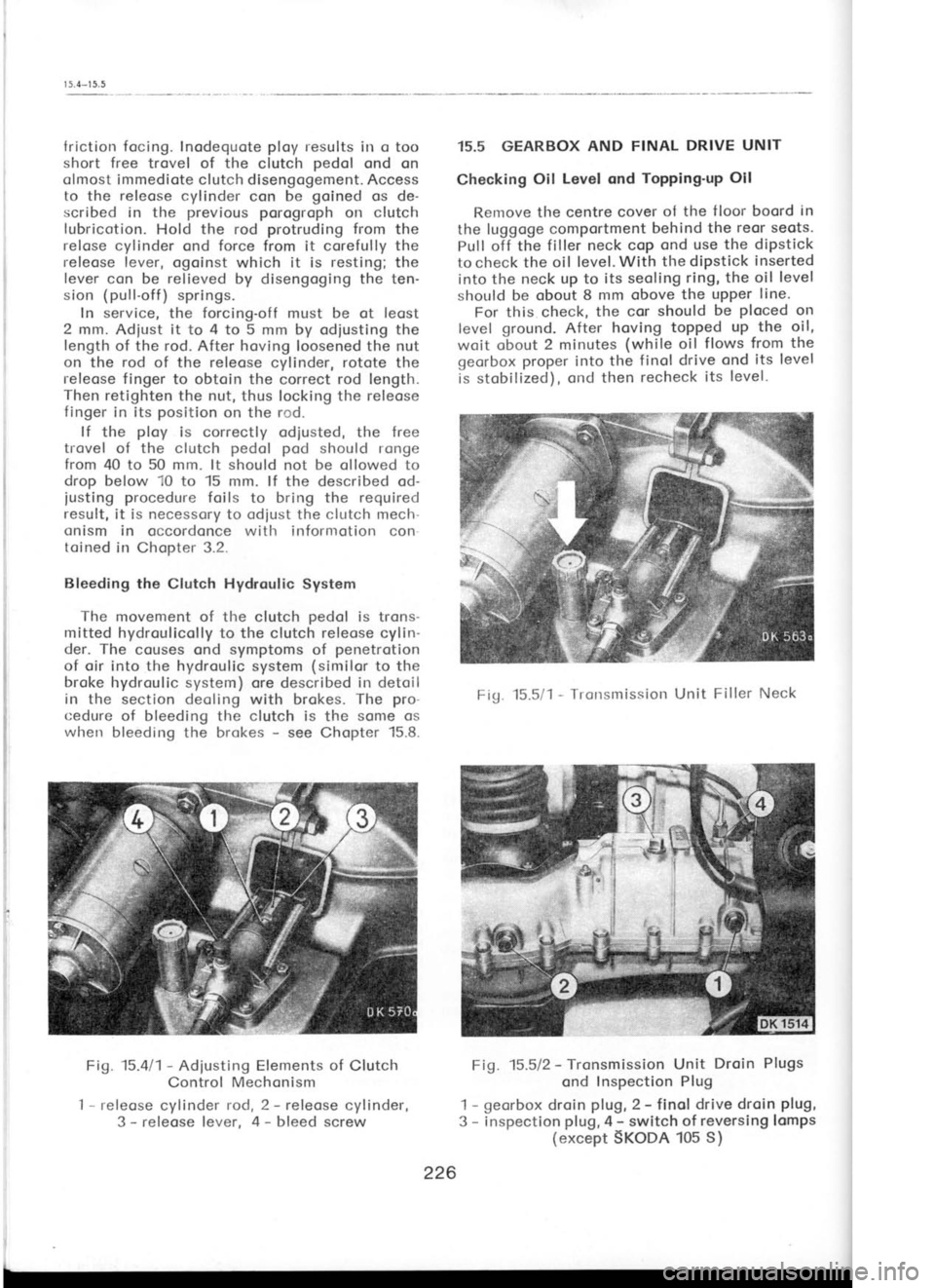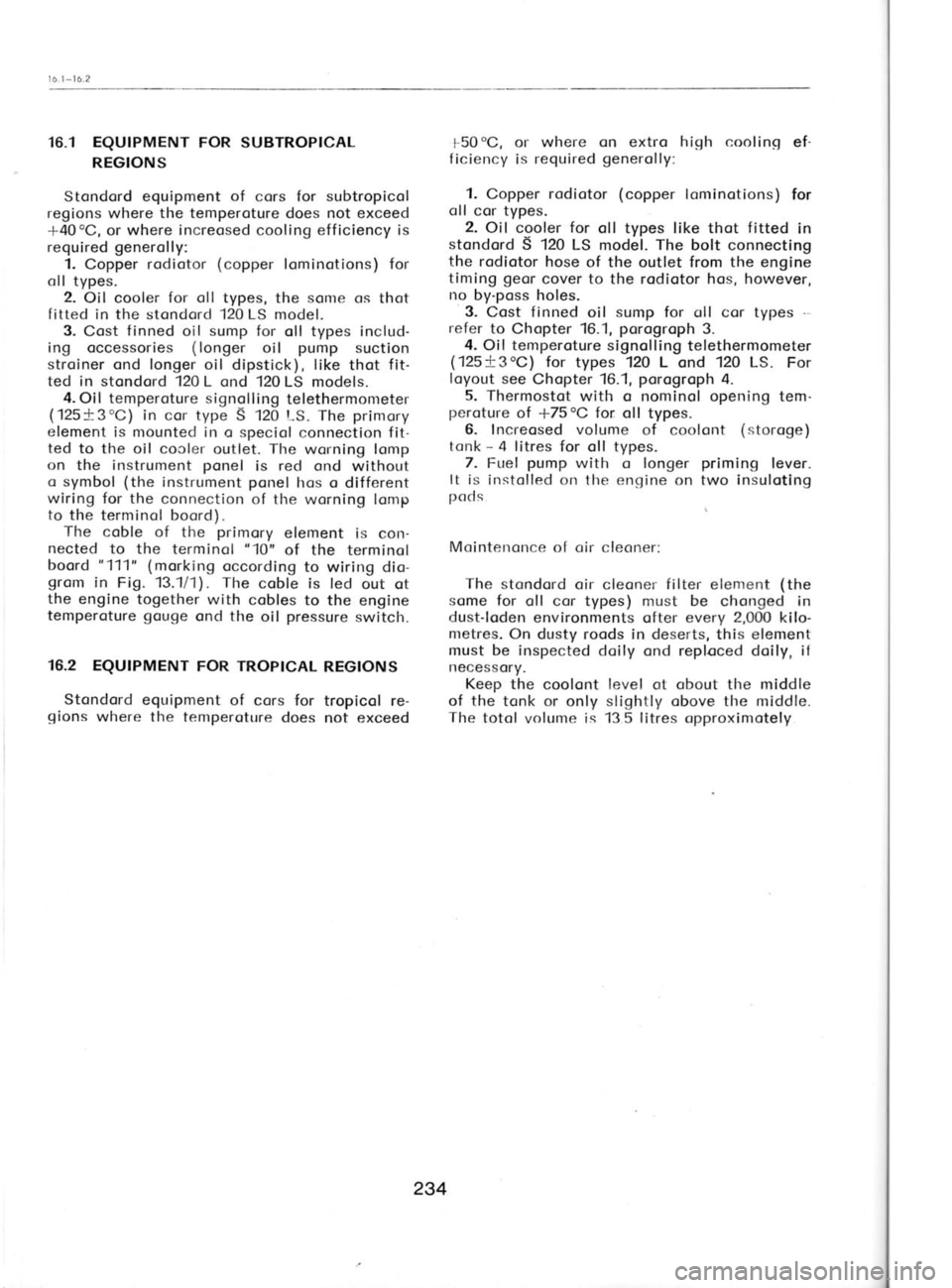1980 SKODA 120 LSE oil level
[x] Cancel search: oil levelPage 201 of 238

I
x
li
I
I
.t
the
ploces
from which you
hove removed the
sticking dirt ogoin, ond wipe
the entire body-
work diy, including chromium'ploted ports,
with
chomois leother. Wosh ond
wlpe dry the vor'
nished surfoces with uniform strokes in one
direction, i. e.
not
by circulor movements.
After hoving wiped oll vornished ports
of the
bodywork dry, polish
them with o soft (flonnel)
duster. Do not use polish
of ony kind.
lf the bodywork is so dirty thot it connot be
woshed cleon with woter, use cor
shompoo.
lf it is necessory to refreshen the gloss
of the
finish, use o cor polish
occording to instructions
of its monufocturer. To wosh the underbody,
use o hose ond
running woter, worm or cold; never use petrol,
kerosene, diesel oil, etc.
Remove greose
spots with o cloth, dry or
sooked in petrol
if necessory. To
remove tor, dip
the cloth in kerosene or o speciol
tor removing
preporotion, ond rub the spots. Then
immediotely
wosh owoy oll troces of
kerosene or the tor
removing solution, ond repolish the spots with
o cor polish.
TOUCHING.UP VARNISH
Preporotion:
Removol of Polishes etc.
When touching up o repoired bodywork (dom-
oged surfoce
finish), it is
importont to olso
cleon the surrounding vornish
to prevent
the
touching-up point
from floking off loter on in
ploces of overlopping.
Remove cor polishes
with o shompoo. Silicone
oil, contoined in some bronds
of polishes
ond
preventing the odhesion of the touching-up
point, con be woshed owoy only with o speciol
preporotion. !n Czechoslovokio, this is
for
exomple VENEDIN. Rub with this preporotion
olso vornished oreos which will be roughened
by grinding
where the bore ploces
poss
into
ground ond cemented oreos.
Removol of Rust
Remove rust mechonicolly by grinding
or
rubbing with emery poper
ond woshing with
c derusting ogent (for
exomple SK 2,
which is
bosicolly o 300/s phosphoric
ocid).
Procedure: f irst cleon the rusty spot with
emery poper
No.80 ond 100
or using o grinder.
Then rub the spot with o 15 0/6
solution of
phosphoric ocid (SK 2 deruSter)
heoted up to
40oC. When using o cold solution,
its concen-
trotion must be obout 300/e (undiluted
SK 2
deruster). Work in rubber gloves.
After hoving removed the rust, wosh
the spot
twice. First
with tepid or cold woter,
soft or softened
by odding 2
to 2.501s of sodo,
then
with o solution of chromium trioxide (1 gr.
to
1 litre of soft
woter) heoted
up
to 80oC (thls
is
the so-colled possivoting
rinse). Now let the
spot dry.
Degreosing Degreose the spot to be touched up by rub-
bing it down with trichloroethylene or technicol
petrol.
1. Touching-up with low-boking points -
the most perfect procedure
o) Cleon the touched-up spot, derust
ond
degreose it (see
the previous
porogrophs
on
preporotion)
b) Sproy over with priming point
c) Let the priming point
dry ot 80oC to 110oC
for o period
of 50
or 15 minutes (50 minutes
ot 85oC, 15
minutes ot 110oC)
d) Coot over with synthetic cement or poly-
ester cement
e) Let the cement dry ot 85oC or 110oC for
o period
of 50 or 15 minutes respectively;
when using polyester
cement, the drying
period con be shortened -
this cement dries
of normol temperoture
f ) Grind under
woter with emery poper
No.280
to320till the spot is perfectly
flot ond even,
ond let it dry
g) Sproy with top-coot vornish
h) Let it dry ot 80oC to 110oC for
o period
of
15 or 50 minutes respectively; ofter boking,
the vornish hos
o high gloss
ond it is not
necessory to polish
it
i) Use o polish
to remove
ony visible troces of
tronsition between the originol ond the
new
vornish.
2. Touching-up with
nitro-combinotion vornish
o) Cleon, grind,
derust, ond degreose the spot
to be touched up
b) Apply priming
point with o brush or o
sproy-gun
c) Level up, if
necessory, with on oil-bose
cement (once
or twice)
d) Let
it dry lor 24 hours ond then grind
with
emery poper
No.220
e) Sproy
the entire touched-up oreo with
sproying cement ond let it dry for 24 hours
f) Grind with
emery poper
No. 280 ond 320
under woter till the oreo is perfectly
smooth
ond flot, ond let it dry
g) Sproy the touched-up spot with o vornish
prepored by mixing low-boking
,vornish
(Toolol ond touching-up vornish (300/e);
use
exclusively o
nitro-thinner for diluting the
vornish
210
Page 216 of 238

friction focing. lnodequote
ploy
results irr o too
short free trovel of the clutch pedol
ond on
olmost immediote clutch disengogement. Access
to the releose
cylinder con be goined
os de-
scribed in the previous porogroph
on clutch
lubricotion. Hold the rod protruding from
the
relose cylinder ond force
from it corefully the
releose lever, ogoinst which it is restingi
the
lever con be relieved by disengoging the ten-
sion (pull-off
) springs.
ln service, the forcing-off
must be ot leost
2 mm. Adiust it to 4
to 5 mm by odiusting the
length of the rod. After hoving
loosened the nut
on the rod
of the releose cylinder, rotote
the
releose finger to obtoin the correct rod
length.
Then retighten the nut, thus locking the releose
f inger in its position
on the rod.
lf the ploy
is correctly od justed,
the f ree
trovel of the
clutch pedol
pod should ronge
from 40 to 50 mm. lt should not be ollowed to
drop below '!0
to 15 mm. lf the described od-
justing procedure foils to bring the required
result, it is necessory to odjust the clutch
mech-
onism in occordonce with
informotion con
toined in Chopter 3.2.
Bleeding the Glutch Hydroulic System
The movement of the clutch pedol
is trons-
mitted hydroulicolly to the clutch releose cylin-
der. The couses ond symptoms of penetrotion
of oir into the hydroulic
system (similor
to the
broke hydroulic system) ore described in detoil
in the section deoling with brokes. The pro-
cedure of bleeding the clutch is the some os
wherr bleeding the brokes -
see Chopter 15.8.
Fig. 15.411-
Adiusting Elements of
Clutch
Control Mechonism
I -
releose cylinder rod, 2 -
releose cylinder,
3 -
releose lever, 4 -
bleed screw 15.5 GEARBOX
AND FINAL DRIVE UNIT
Checking Oil
Level ond Topping'up
Oil
Renrove the centre cover ol the
f loor boord in
the luggoge comportment behind the
reor seots.
Pull off the filler neck cop ond use
the dipstick
to check the oil level. With the diPstick inserted
into the neck up to its seoling ring, the oil level
should be obout 8 mm obove the upper line'
For this check, the cor
should be ploced
on
level ground.
After hoving topped up the oil,
woit obout 2 minutes (while
oil flows from the
georbox proper
into the finol drive ond its level
is stobilized), ond then recheck
its level-
Fig. 15.5/1 -
Tronsmission Unit Filler Neck
Fig. 15.512 -
Tronsmission Unit Droin
Plugs
ond Inspection Plug
1 -
georbox droin plug,
2 -
finol drive droin plug,
3 -
inspection plug,
4 -
switch of reversing lcmps
(except SKoDA 105 S)
ffi
;rt'i,*
tiiffi
ii.! i;
br'ill
226
Page 220 of 238

r
5.9-15. r
2
Dismontle the housing, remove
old greose,
cleon the individuol ports,
opply fresh greose,
ond reossemble the housing. Sook the felt rings
on the links (pull-rods)
in engine oil.
15.10 WHEELS AND TYRES, SNOW
CHAINS
Tyre Inflotion, Boloncing
ond lnterchonge
of Wheels
The procedures ore outlined in
Chopters 10.1
through 10.3. Snow
choins ond their use ore
deolt with in Chopter 10.6.
Wheel Toe-in -
see Chopter 16.1.
Shock Absorbers -
see Chopter 8.3 "Shock
Absorbers ".
15.11 ELECTRTCAL EQUTPMENT
Checking electrolyte level ond topping up --
see Chopter 13.2.
Sporking plugs -
electrode gop
odiustment,
etc. -
see Chopter 13.7.
Stqrter motor -
exqminqtion ond renewol of
brushes, etc. -
see Chopters 13.11 through 13.14.
lgnition timing, odiustment of contoct breoker
point gop, distributor lubricotion -
see Chop-
ter 15.3.
15.12 BODYWORK -
UNDERBODY
Woshing ond Mointenonce
The visible ports
of the body qre
f inislred in
o hord synthetic boking vornish, the remoining
ports in synthetic vornish.
The underbody is sproy-cooted
with o plostic
compound -
for detoiled informotion, see Chop-
ter '14.9.
Follow the
usuol procedures
when
woshing, cleoning ond polishing
the cor, ond
observe the specific instructions for
the use of
woshing ond cleoning preporotions,
issued by
their monufocturers.
All lights with the exception
of heodlomps
hove cosings of plostic
moteriols qnd
they
should be cleoned onlywith woteror shompoos.
When hosing down the corr
cover the voltoge
regulotor of the olternotor ond
the ignition coil
to protect
them ogoinst sploshing with woter,
ond do not
sproy woter direct on
the door lock
ond the lid covering the fuel
tonk filler neck.
Woshing ond Core of Underbody
Mechonisms
The underbody mechonisms
ore protected
with o synthetic vornish which stonds
well the
usuol woshing procedures.
Protect oll rubberports
ogoinst direct contoct with speciol chemi-
col solvLnts or limit the durotion of this
contoct
to o minimum before
o complete woshing off of
the solvents with woter (by
hosing down, etc.)'
Keep the oil cooler, if fitted on
the cor, in
cleon'condition. Hose
it down when woshing
the cor, ond if dirt still
sticks to the cooling
surfoces, use some of the detergents.
Bodywork Lubricotion
Routine mointenonce includes the
lubricotion
of door hinges ond limiters, hinges
ond releose
mechonismi of the engine bonnet ond boot lid,
the releose mechonism of
the spore wheel,
ond
the leveroge of windscreen wipers. Lubricotion
of inner dolor mechonisms is
included in
speciol
mqintenonce. Lubricote oll occessible mechcnisms
with
high-quolity greoses which
do not
dry, do not
oxldize, ond protect
the mechonisms ogoinst
corrosion for o long time. Oil is
not suitoble due
to its short-time efJect. Any greose con
be used
to lubricqte the
door limiters ond
the front
seot
slide roils.
Lubricotion of SporeWheel Corrier
Bearings-
Remove the spore wheel,
cleon the hinges, ond
opply oil on iheit
upper sides. In oddition, rub
in greose of ony brond.
Lubricotion of Windscreen Wiper
Leveroge -
Remove the cover of the
ioint (o
plostic cup),
f ill it with greose, lubricote the
ioint, ond
rein-
stoll tlre cover.
The Lubricotion of
Inner Door Mechonisms
is possible only
ofter removing the
door ponel
ond the inner 'door
mechonism. Use
only re-
commended greose brcnds.
Lubricote
the bowden
coble of thJwindow wind-up mechonism
with
Fig.15.1211- Lubricotion
of Windscreen Wiper
Leveroge Joint -
ioint cover
230
Page 224 of 238

16.1
-
16.2
16.1 EQUTPMENT FOR SUBTROPTCAL
REGIONS
Stondord equipment of
cors for subtropicol
regions where the temperoture
does not exceed
+40oC, or where
increosed
cooling efficiency is
required generolly:
1. Copper rodiotor (copper
lominotions) for
oll types. 2. Oil cooler for oll types,
the some
os thot
fitted in the stondord
12O LS
model.
3. Cost finned
oil sump for oll types includ-
ing occessories (longer
oil pump
suction
stroiner ond longer oil dipstick), like thot fit-
ted in
stondord 120 L ond 120 LS models.
4. Oil temperoture signolling
telethermometer
(125+3'C) in cor type S 120 t-S.
The primory
element is mounted in o speciol connection fit-
ted to the oil cooler outlet. The worning lomp
on the instrument ponel
is red
ond without
o symbol (the
instrument ponel
hos o different
wiring for the connection of the worning lomp
to the terminol boord).
The coble of the primory
element is con-
nected to the terminol "10"
of the terminol
boord "111"
(morking occording to wiring dio-
grom in Fig. 13.1/1).
The
coble is led out ot
the engine together with
cobles to the engine
temperoture gouge
ond the oil pressure
switch.
16.2 EQUTPMENT FOR TROP|CAL
REGTONS
Stondord equipment of cors for tropicol re-
gions where the temperoture does not exceed f
50 oC,
or where on
extro high cooling
ef-
f iciency is required generolly:
1. Copper rodiotor (copper
lominotions) for
oll cor types.
2. Oil cooler for
oll types like thot fitted
in
stondord S 120 LS mod6l. The bolt
connecting
the rodiotor hose of the outlet from the engine
timing geor cover to the rodiotor hos, however,
no by-poss holes.
3. Cost finned
oil sump
for oll cor types -
refer to Chopter 16.1, porogroph
3.
4. Oil temperoture signolling telethermometer
(125+3oC) for types 120 L
ond 120 LS.
For
loyout see Chopter 16.1, porogroph
4.
5. Thermostot with o nominol opening tem-
peroture of +75oC for oll
types.
6- Increosed volume of coolont (storoge)
tonk -
4 litres for oll types.
7. Fr-rel pump
with o longer priming
lever.
It is instolled on the engine on two insuloting
pcrd s
Mointenonce of oir clecner:
The stondord oir cleoner filter element (the
some for oll cor types) must be
chonged in
dust-loden environments ofter every 2,000
kilo-
metres. On dusty roods in deserts, this element
must be inspected doily ond reploced doily, it
necessory.
Keep the coolont level
ot obout the middle
of the tonk or only slightly obove the middle.
The totol
volume is 13 5 litres opproximotely
234